100 ECG’s
IHD ECGs: (28 questions)
Questions
-
1
A 50 year old man experiences severe crushing chest pain whilst cleaning the house. He has a history of angina and is on GTN for that. His GTN did not help him on this occassion and the pain lasted 30 minutes. He was taken to hospital via ambulance for primary angioplasty and following that was admitted to the coronary care unit for monitoring. His ECG on admission to the coronary care unit is shown. Which artery is the most likely culprit ? 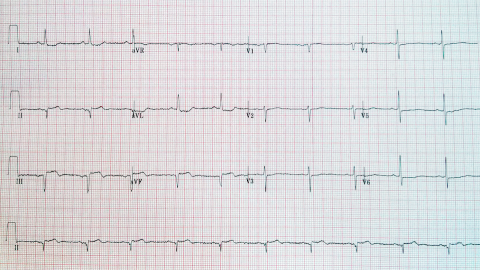
a Proximal Left anterior descending b Distal Left anterior descending c Left main stem d Right coronary artery e Aortic Root -
2
A 25-year old rockstar is rushed into hospital at 3am complaining of severe crushing chest pain and palpitations of 15 minutes duration. He has been partying prior to that at his city penthouse with his fellow artists and fans. He has no past medical history except for ENT follow up for a necrotic nasal septum of one year duration. He has a family history of premature ischaemic heart disease and smokes 20 cigarettes per day. He hesitantly admits to using a cocktail of drugs on a regular basis including cannabis, ecstasy, cocaine and crystal meth. ECG is shown. Which cardiac drug is contraindicated in this patient ? 
a Ramipril b Metoprolol c Nifedipine d GTN e Atorvastatin -
3
A 57 year old accountant is brought by ambulance complaining of central crushing chest pain. He has a longstanding history of hypertension and is a smoker. His ECG is shown. Which is the most likely culprit artery ? 
a Proximal Left anterior descending b Distal Left anterior descending c Right coronary artery d Acute Marginal e Obtuse marginal -
4
A 75 year old retired carpenter presents to the emergency department with profuse sweating, chest heaviness and palpitations. He has a history of diabetes, hypertension and is an ex-smoker. His ECG is shown. What is the most likely culprit artery? 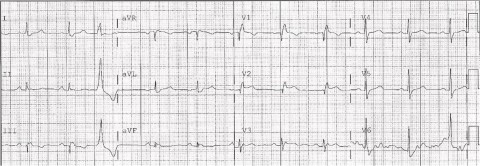
a Left main stem b Left anterior descending artery c Circumflex artery d Right coronary artery e Posterior interventricular artery -
5
A 72 year old man attends the emergency department with central chest tightness, shortness of breath and sweating of thirty minutes duration. His past medical history includes hypertension and diabetes. His is an ex-smoker of 20 pack year. An ECG is done in the emergency room (shown). A decision on treatment is being made because this hospital does not do percutaneous coronary intervention (PCI). Which is the most appropriate treatment? 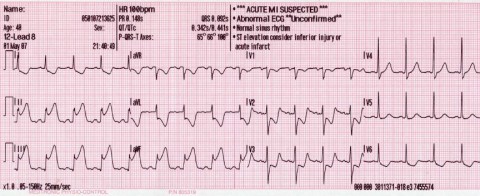
a Give Aspirin, Clopidogrel and Fondaparinux and management medically b Manage medically with GP IIb/IIIa antagonist Tirofiban c Thrombolyze if the troponin is positive d Thrombolyze regardless of troponin e Transfer to another hospital 3 hours away for PCI -
6
A 57 year old man presents to the emergency department complaining of central crushing chest pain and sweating. His heart rate is 120 and his blood pressure is 90/70. His ECG is shown. Which of the following ACS treatments is contraindicated in this case? 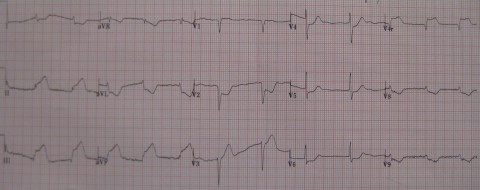
a Morphine b Oxygen c GTN d Aspirin e IV Fluids -
7
An 80 year old retired gentleman is admitted to the coronary care unit with chest pain and the following ECG (Shown). He undergoes the appropriate therapy and is placed in a monitored bed. 48 hours later, the nurse notes a deterioration in his state with a drop of blood pressure from 125/89 to 84/60. He is tachycardic and tachypnoeaic. On examination he has a new pansystolic murmur heard loudest at the lower left sternal edge. What is the most likely diagnosis ? 
a Reinfarction b AV node infarct c Papillary muscle rupture d Ventricular septal rupture e LV free wall rupture -
8
A 52 year old man attends the emergency department complaining of central crushing chest pains. He has not seen a doctor for 20 years. The admitting doctor does an ECG (shown). What is the diagnosis ? 
a Left bundle branch block with anterior MI b Left bundle branch block with no ischaemic changes c Right bundle branch block with anterior MI d Right bundle branch block with no ischaemic changes e Uninterpretable as it has right bundle branch block pattern -
9
A 62 year patient presents to the emergency department with central crushing chest pain. He has a long history of hypertension, asthma and duodenal ulcer. He also sees his GP for obsessive compulse disorder. The admitting doctor performs an ECG and implements the appropriate treatment. What are the ECG findings (shown) ? 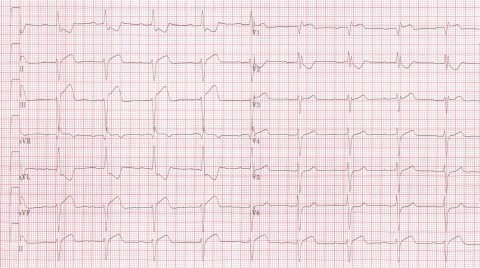
a Left bundle branch block with inferior MI b Right bundle branch block, left axis deviation and inferior MI c Right bundle branch block, right axis deviation and inferior MI d Left bundle branch block, right axis deviation and inferior MI e Left axis deviation and inferior MI -
10
A 57 year old patient presents to the emergency department with central crushing chest pain radiating to the left arm and associated with shortness of breath for 1 hour duration. His ECG is shown. Which of the following medications given to ACS patients has the best mortality benefit ? 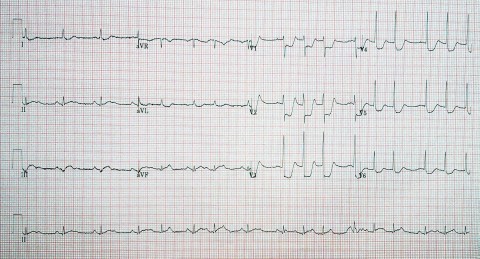
a Morphine b Metoclopramide c Oxygen d Nitrates e Aspirin -
11
A 62 year old gentleman presents to the cardiology clinic for follow up after having had an MI 6 months ago. His ECG from the original admission is shown. He has now developed signs of heart failure and his echo is showing a reduced ejection fraction. Which of the following beta-blockers is proven to provide a mortality benefit in such patients ? 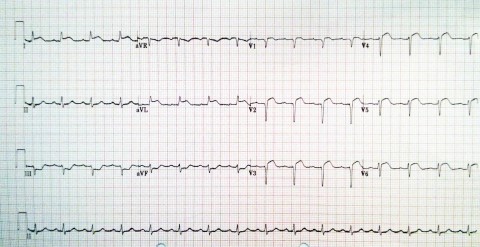
a Atenolol b Acebutolol c Carvedilol d Labetalol e Timolol -
12
A 55 year old man attends the emergency department with chest pain and shortness of breath on exertion. He complains that he normally gets very short of breath after walking 500 metres, however in the last few weeks his exercise tolerance has decreased to 200 metres on the flat associated with central crushing chest pain. His pain remits when he rests for a few minutes. His ECG is shown. His troponin I comes back as 0.02 (Normal <0.03). What is the best combination of medications for him? 
a Aspirin and Clopidogrel b Aspirin and Metoprolol c Metoprolol and GTN d Clopidogrel and GTN e Clopidogrel and Fondaparinux -
13
A 65 year old man presents to hospital with central crushing chest pain. He has a history of hypertension, diabetes, hyperlipidaemia and is a current smoker. His systolic blood pressure is 150 and his heart rate is 90. His overall GRACE score is consistent with a 5% mortality rate at 6 months. His ECG is shown. His troponin is elevated. What is the best course of action ? 
a Exercise tolerance test b Manage medically and discharge c Manage medically and perform angiography in 6 weeks d Manage medically and perform immediate angiography e Watch and wait for symptom recurrence -
14
A 76 year old retired civil servant attends the emergency department with sudden onset central crushing chest pain of 60 minute duration. His past medical history includes hypertension and diabetes. He is an ex-smoker. You review the ECG (shown). Which of the following is the best step to improve mortality outcomes in these patients ? 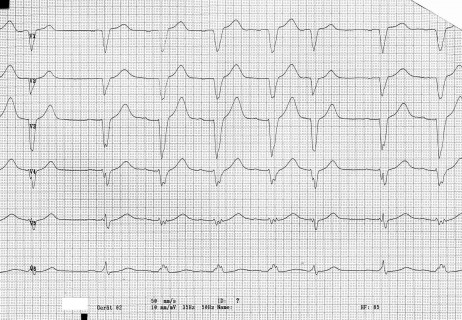
a Give Aspirin b Give Morphine and Metoclopramide c Start transcutaneous pacing d Give Nitrates e Give Oxygen -
15
A 62 year old man is admitted to the emergency department with central crushing chest pain of 1 hour duration. An ECG is done immediately (shown) and a troponin level which comes back positive. He is given a cocktail of medications including Tirofiban. Which class of drugs is Tirofiban in ? 
a ACE inhibitors b Cycloxygenase inhibitors c GP VI inhibitors d GP IIb/IIIa inhibitors e Factor Xa inhibitor -
16
A 62 year old man with central crushing chest pain and the ECG shown is admitted to the coronary care unit following treatment. 24 hours later, he develops sudden onset shortness of breath. On examination, his blood pressure is 87/49 and pulse is 130. There is an audible systolic murmur over the apex. What is the most likely diagnosis ? 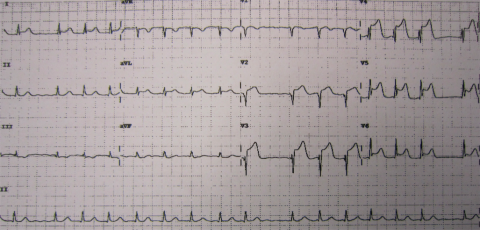
a Papillary muscle rupture b LV free wall rupture c Reinfarction d Ventricular septal rupture e AV node infarct -
17
A 69 year old woman with central crushing chest pain and an extensive history of diabetes and hypertension is admitted to the coronary care unit with the ECG shown. She receives the appropriate treatment. 24 hours later, she becomes unwell and is very drowsy and pale. On examination, her blood pressure is 86/40 and her heart rate is 134. Her heart sounds are distant and muffled and her jugular venous pressure is elevated. What is the diagnosis ? 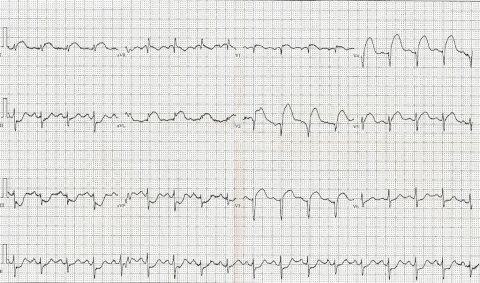
a Papillary muscle rupture b LV free wall rupture c Reinfarction d Ventricular septal rupture e AV node infarct -
18
A 55 year old man is admitted to the coronary care unit with the ECG shown. He receives the appropriate treatment and is discharged. Nine months later, he attends the emergency department with an episode of ventricular arrhythmia which is treated successfully. Echocardiography shows a dilated heart. He is on maximum medical therapy. Which of the following interventions will make the biggest mortality benefit ? 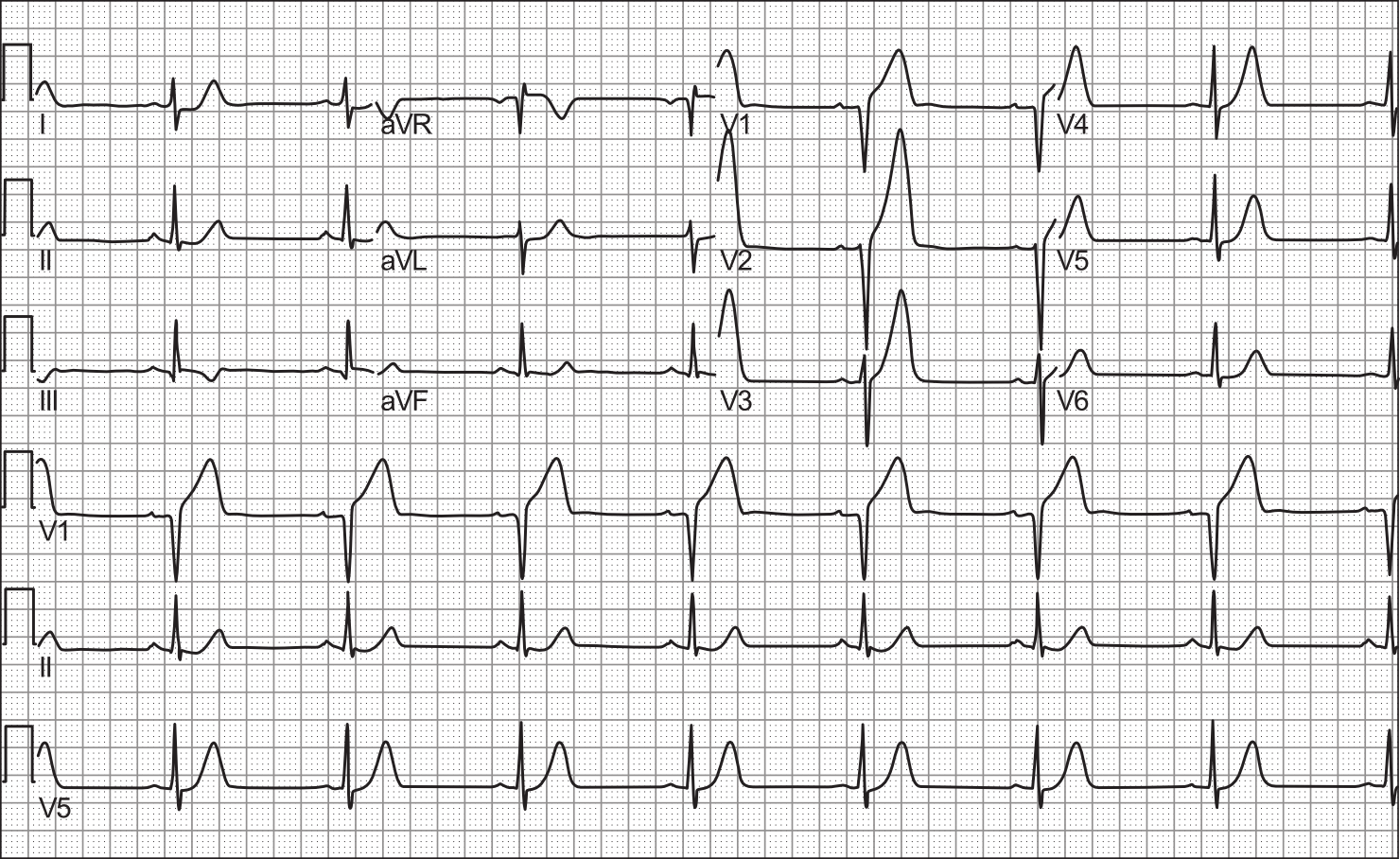
a Left Anterior Descending revascularisation b Coronary Artery Bypass Graft c Permanent Pacemaker (PPM) d Implantable Cardioverter Defibrillator (ICD) e Holter Monitor -
19
A 75 year old woman with a history of transient ischaemic attacks is brought in by ambulance complaining of central crushing chest pain. Her medications are co-codamol, vesicare and gaviscon. Her ECG is shown. Her troponin is raised and she is rushed into the cath lab for an angiogram. Her angiogram shows no significant vessel stenosis and traces of a distal clot in her left anterior descending. What is the cause of this ECG appearance ? 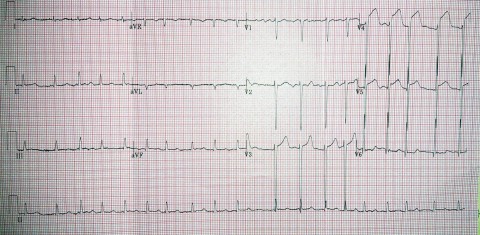
a Atherosclerotic plaque rupture b Embolus c Pericarditis d Paradoxical embolus e Aortic dissection -
20
A 78 year old patient presents with sudden onset central sharp chest pain that has been ongoing since he started mowing the lawn 2 hours ago. The patient is immediately given aspirin, nitrates, oxygen and morphine. An ECG is done (shown). His blood pressure is 134/81 and his heart rate is 90. What is the diagnosis ? 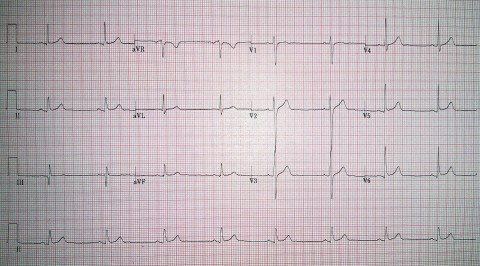
a Inferior ST-elevation MI b Lateral ST-elevation MI c Anterior ST-elevation MI d Costochondritis e Angina -
21
A 76 year old man phones the ambulance complaining of central crushing chest pain of one hour duration associated with sweating and nausea. The pain is radiating to his left arm. His past medical history includes diabetes and hypertension. His ECG is shown. He receives the appropriate treatment which includes clopidogrel. What is the mechanism of action of clopidogrel ? 
a ADP receptor antagonist b GPVI receptor antagonist c GPVI receptor antagonist d Factor Xa inhibitor e Cycloxygenase inhibitor -
22
A 55 year old man attends the emergency department with central crushing chest pain of one hour duration associated with sweating and nausea. The pain is radiating to his left arm. His past medical history includes diabetes and hypertension. His ECG is shown. He receives the appropriate treatment which includes prasugrel. What is the mechanism of action of prasugrel ? 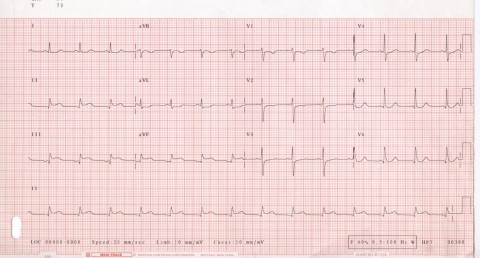
a ADP receptor antagonist b GPVI receptor antagonist c GPVI receptor antagonist d Factor Xa inhibitor e Cycloxygenase inhibitor -
23
A 63 year old man is admitted to the coronary care unit with the ECG shown. He receives the appropriate treatment and is discharged. Nine months later, he complains of increasing exercise intolerance and he gets short of breath after walking up 5 to 6 steps of stairs. Echocardiography shows a dilated heart, ejection fraction of 29%, and dysynchronous ventricles. ECG shows a wide QRS complex secondary to left bundle branch block. He is on maximum medical therapy. Which of the following interventions is most appropriate to improve the patient’s condition ? 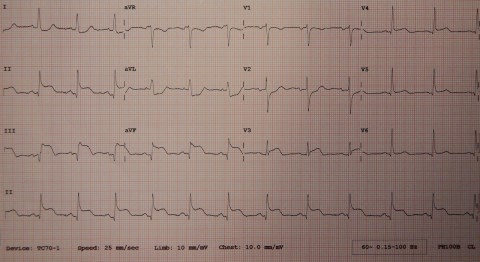
a Left Anterior Descending revascularisation b Coronary Artery Bypass Graft c Dual-chamber pacemaker (PPM) d Implantable Cardioverter Defibrillator (ICD) e Biventricular pacemaker (CRT) -
24
A 55 year old man phones the ambulance complaining of central crushing chest pain of one hour duration associated with sweating and nausea. The pain is radiating to his left arm. His past medical history includes diabetes and hypertension. His ECG is shown. The ambulance crew immediately administer aspirin 300mg and activate the PCI lab. What is the mechanism of action of Aspirin ? 
a ADP receptor antagonist b ADP receptor antagonist c GPIIbIIIa antagonist d Factor Xa inhibitor e Cycloxygenase inhibitor -
25
A 64 year old man is rushed to the emergency department by his son after complaining of central crushing chest pain of 45 minute duration. His pain radiates to the left shoulder and is associated with shortness of breath. An ECG is done immediately (shown) and a troponin sample is taken which comes back positive. He is given aspirin, clopidogrel and fondaparinux. What is the mechanism of action of fondaparinux ? 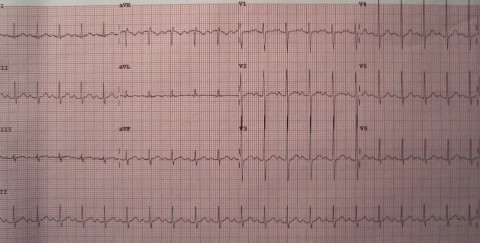
a ADP receptor antagonist b GPVI receptor antagonist c GPIIbIIIa antagonist d Factor Xa inhibitor e Cycloxygenase inhibitor -
26
A 64 year old man is rushed to the emergency department by his son after complaining of central crushing chest pain of 45 minute duration. His pain radiates to the left shoulder and is associated with shortness of breath. An ECG is done immediately (shown) and a troponin sample is taken which comes back positive. He is given aspirin, clopidogrel and unfractionated heparin. What is the mechanism of action of heparin ? 
a ADP receptor antagonist b ADP receptor antagonist c GPVI receptor antagonist d Factors IIa and Xa inhibitor e Factors IIa and Xa inhibitor -
27
A 70 year old man is brought to the emergency department by ambulance after complaining of central crushing chest pain of 50 minutes duration. His pain radiates to the left shoulder and is associated with shortness of breath. An ECG is done immediately (shown) and a troponin sample is taken which comes back positive. He is given aspirin, heparin and tirofiban. What is the mechanism of action of tirofiban ? 
a ADP receptor antagonist b GPVI receptor antagonist c GPIIbIIIa antagonist d Factors IIa and Xa inhibitor e Cycloxygenase inhibitor -
28
A 55 year old man attends his GP practice complaining of shortness of breath on exertion. He is a current smoker with hypercholesterolaemia and hypertension. He reports feeling shortness of breath after walking for 100 yards. This is relieved when he rests for 1-2 minutes and lasts no longer than 5-10 minutes at a time. Sometimes it is accompanied by chest tightness. His ECG is shown. The prescribes glyceryl trinitrate spray for this patient. What is the primary mechanism of action of this medication ? 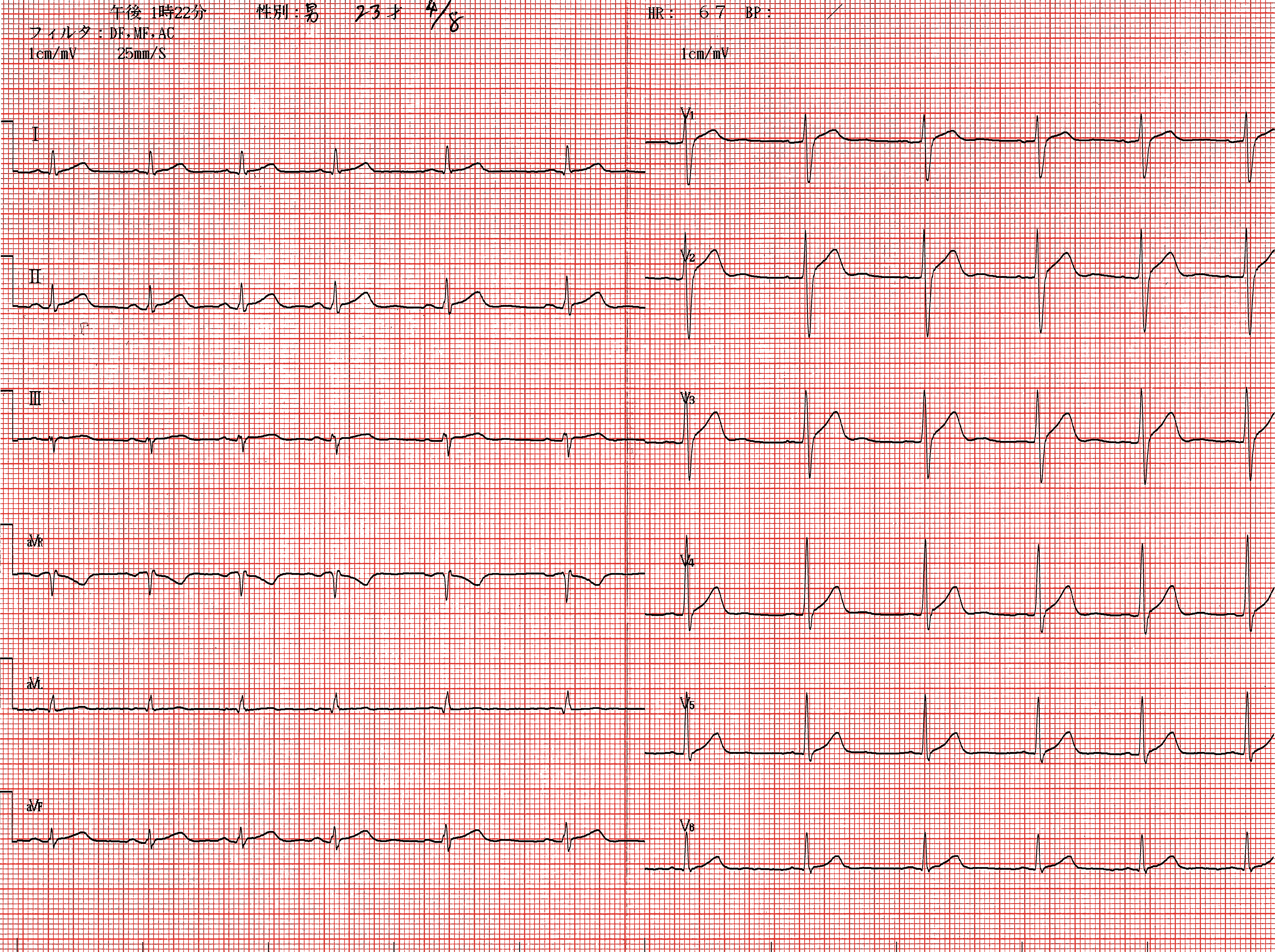
a Coronary vasodilation b Inhibition of the renin-angiotensin system c Negative Chronotrope d Negative Inotrope e Preload reduction